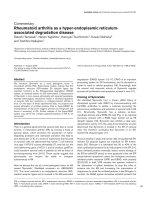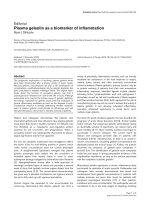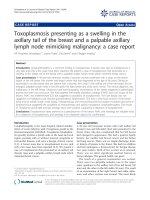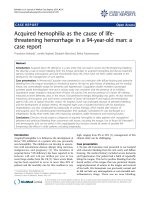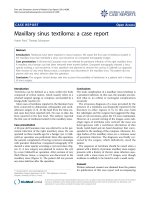Báo cáo y học: "Recurrent furunculosis as a cause of isolated penile lymphedema: a case report" docx
Bạn đang xem bản rút gọn của tài liệu. Xem và tải ngay bản đầy đủ của tài liệu tại đây (546.42 KB, 3 trang )
JOURNAL OF MEDICAL
CASE REPORTS
Al-shaham and Sood Journal of Medical Case Reports 2010, 4:196
/>Open Access
CASE REPORT
© 2010 Al-shaham and Sood; licensee BioMed Central Ltd. This is an Open Access article distributed under the terms of the Creative
Commons Attribution License ( which permits unrestricted use, distribution, and repro-
duction in any medium, provided the original work is properly cited.
Case report
Recurrent furunculosis as a cause of isolated penile
lymphedema: a case report
Ali A Al-shaham* and Suneet Sood
Abstract
Introduction: Isolated lymphedema of the penis is extremely rare: combined involvement of the scrotum and penis is
the norm. Furunculosis as a cause is not, to our knowledge, previously reported. We present a case of isolated penile
lymphedema that responded to excision of lymphedematous tissue and reconstruction with flaps.
Case presentation: A 32-year-old Arab man presented with a three-year history of a gradually increasing, painless
penile swelling. Our patient's main complaint was non-erectile sexual dysfunction. The swelling was preceded by at
least three prior episodes of severe furunculosis at the penile root. He had no other contributory past medical or family
history. On examination there was gross penile enlargement, maximally at the mid shaft, associated with thickened
skin at the sites of prior furunculosis. The glans and scrotum were normal. Both testes were palpable. Serology for
filariasis, and urinary tract ultrasound and computed tomography scan were normal. The clinical diagnosis was
lymphedema following recurrent penile furunculosis. At operation the lymphedematous tissues were removed.
Closure of the penile shaft was accomplished by bilateral advancement of flaps from both ends of the penis. He
resumed normal sexual activity one month after surgery. At 12 months, he had a good cosmetic result, with no signs of
recurrence.
Conclusions: Furunculosis at the penile root may result in lymphedema confined to the penile shaft, sparing the
scrotum. Excision of abnormal tissue and cover with a skin flap gave excellent cosmetic results, and allowed satisfactory
sexual activity.
Introduction
Although peno-scrotal lymphedema is common, isolated
penile lymphedema is extremely rare [1]. A literature
review for the last 30 years revealed only two cases of iso-
lated penile involvement. In the first, chronic lymphatic
edema occurred due to long term usage of a penile ring
[2]. In the second case [3] the penile swelling resulted
from donovanosis. We present a case of isolated penile
lymphedema that was caused by recurrent skin infection.
Genital lymphedema is an accumulation of lymph in
the superficial lymphatic channels between skin and fas-
ciae: Colles' fascia in the scrotum and Buck's fascia in the
penis [4]. The testes, the spermatic cord, the corpora, and
the glans drain into the deep lymphatics, and are not
affected by the disease process. Penoscrotal lymphedema
is disfiguring. It is also associated with pain, difficulties
with urination, and sexual dysfunction [5,6]. Diagnosis of
lymphedema is easy, but determining its etiology is much
more difficult. Conditions that damage the penile lym-
phatics, resulting in lymphedema, include neoplasia, sur-
gical trauma and radiation. Chronic or recurrent acute
infection may also cause lymphedema. Examples include
donovanosis, tuberculosis and parasitic diseases such as
filariasis [7]. Primary lymphedema is less common, and is
due to an intrinsic abnormality in lymphatic channels,
such as lymphatic aplasia, hypoplasia and hyperplasia.
Elephantiasis is a term usually applied to long standing
lymphedema with numerous folds and variable thicken-
ing in the skin and hardening of the subcutaneous tissue
due to fibrosis.
Case presentation
A 32-year-old Arab man presented with a three-year his-
tory of a painless fusiform swelling in the penis. The
swelling was preceded by three episodes of furunculosis
* Correspondence:
1
Faculty of Medicine, Universiti Teknologi MARA, Level 11, Dean's Office,
Selayang Hospital, Selayang-Kepong Road, Batu Caves, Selangor 68000,
Malaysia
Full list of author information is available at the end of the article
Al-shaham and Sood Journal of Medical Case Reports 2010, 4:196
/>Page 2 of 3
over a nine-month period, soon after which he developed
this swelling. The infection itself was characterized by
relapses and remissions, with the total duration of infec-
tion being four months within these nine months. The
infection was associated with pus that discharged sponta-
neously through minute sinuses. It responded very slowly
to systemic and local antibiotic treatment as well as
improved personal hygiene. Eventually healing was
accomplished, leaving the penile skin thickened and
irregular.
The onset of the swelling was gradual, with edema that
spread circumferentially and peripherally along the penile
shaft. Our patient's main complaint was non-erectile sex-
ual dysfunction. He had no urinary tract symptoms.
There was no history of irradiation, surgery, trauma, or
travel to areas endemic with filariasis. He denied a con-
tributory family history. On examination he had gross
penile enlargement, maximally at the mid shaft, where
the circumference was 21 cm. The skin was thick, with
numerous irregular shallow folds (Figure 1). The glans
penis, penile root, scrotal sac, thigh and perineal skin
were normal. Both testes could be identified easily. He
maintained poor local hygiene. Serology for filariasis was
normal, and ultrasound of testes and lower urinary tract
as well as abdominal computed tomography (CT) scan
showed no abnormality. The clinical diagnosis was sec-
ondary lymphedema following recurrent penile furuncu-
losis.
We planned surgery for our patient. Written informed
consent was obtained after an explanation of the proce-
dure and expected outcomes. The operation was started
by two circular incisions around the penile shaft at the
penile corona and root level, followed by a median dorsal
incision made through skin and subcutaneous tissue. The
incisions were carefully extended down to Buck's fascia
from the penile root to the coronal sulcus. The two lateral
lymphedematous segments of tissue were separated from
the fascia by sharp dissection, leaving the penile shaft
exposed. Closure of the penile shaft was accomplished by
bilateral advancement of sleeve-like flaps from both ends
of the penis and suture with monofilament non-resorb-
able suture (Figure 2).
Histopathologic examination showed non-specific
chronic inflammation with areas of epidermal thickening
and dermal fibrosis.
The wound healed well, and sutures were removed on
the 14th post-operative day. Antibiotic cover with peni-
cillin was administered one day pre-operatively and for
14 days post-operatively. He made an uneventful recov-
ery. He had residual edema in the reflected mucosa of the
coronal sulcus, which disappeared within one month. He
resumed a normal sexual activity one month after sur-
gery. At 12 months, he had a good cosmetic result, with
no signs of recurrence.
Discussion
Male genital lymphedema typically involves the scrotum,
and involvement of the penile shaft occurs late. Isolate
penile lymphedema may result from surgery, irradiation,
or from certain chronic infections.
Long standing penile skin infection with subsequent
fibrosis in the subcutaneous tissue outside the tunica may
obstruct the lymphatic channels leading to development
Figure 1 Pre-operative views of the patient with penile lym-
phedema.
Figure 2 Bilateral advancement of sleeve-like flaps to ensure clo-
sure.
Al-shaham and Sood Journal of Medical Case Reports 2010, 4:196
/>Page 3 of 3
of penile lymphedema. Genital lymphadema following
recurrent furunculosis has not been reported. Our
patient probably developed recurrent furunculosis due to
poor personal hygiene, which was also evident at the time
of the current presentation. In our patient the chronic
infection caused extensive lymphatic damage at the
penile root, with consequent lymphedema.
Although significant improvement is possible by a vari-
ety of methods, the treatment of choice in genital lym-
phedema is excision of all abnormal tissue [6-8]. This is
easy; the challenge is in providing a cover to exposed
areas. There are two options: a local skin flap and a split
skin graft [7-11]. The posterior scrotal and the perineal
skin have a collateral lymphatic drainage and are usually
available and can be used to generate flaps for scrotal
reconstruction.
Dandapat et al. [6], reviewing 350 cases, concluded that
satisfactory results were achieved by using local flaps to
the scrotum. They recommended split thickness skin
grafts for penile cover. Tapper et al. [12] were able to
cover the scrotum and penis by local skin flaps after exci-
sion of the lymphedematous tissue. The results were sat-
isfactory at one year of follow up. Longer follow up was
required in predicting the recurrence, especially in flap
cases. Yormuk et al. [8] described a case where surgical
excision was performed for recurrent lymphedema. They
used a local flap to cover the scrotum and a split thick-
ness skin graft for the penile cover. There was a good
result at five years of follow up.
The unavailability of nearby normal skin to cover the
penile part by flaps leaves surgeons with only the choice
of skin graft. McDougal [13] suggested that the inner
preputial skin can be spared and used for partial penile
coverage in uncircumcised patients. Alternatively, sleeve-
like flaps at both ends, when available, can be advanced
bilaterally to provide good cover, as in our case. The flap
has better cosmetic results, but a higher incidence of
local recurrence [6,13]. Malloy et al. [5] advocated the use
of a split skin graft for penoscrotal elephantiasis after
they noticed some cases of recurrence in the local flap.
The split skin graft has the advantage of lower recurrence
rates, but the cosmetic results are poorer [4,6,8,9] and the
subsequent contraction in the skin graft decreases the
graft elasticity: this imposes additional problems during
erection. We suggest that a flap provides penile cover
with better cosmesis, low contraction rates, and adequate
elasticity for erection. If one is compelled to use a graft, a
full thickness graft (Wolfe) may be a better choice than a
split thickness graft. Mesh grafts [11] yield poor cosmetic
results, and are rarely required.
Conclusions
Long standing skin infection with subsequent fibrosis
may lead to development of penile lymphedema. We
present a patient who developed isolated penile lym-
phedema following recurrent furunculosis. After lym-
phedema excision, cover of the denuded penile shaft by
tailored skin flaps provided excellent cosmetic results and
good sexual function.
Consent
Written informed consent was obtained from the patient
for publication of this case report and any accompanying
images. A copy of the written consent is available for
review by the Editor-in-Chief of this journal.
Competing interests
The authors declare that they have no competing interests.
Authors' contributions
AA saw and operated on the patient. SS was the major contributor in the prep-
aration and revision of the manuscript. Both authors have read and approved
the final version of the manuscript.
Author Details
Faculty of Medicine, Universiti Teknologi MARA, Level 11, Dean's Office,
Selayang Hospital, Selayang-Kepong Road, Batu Caves, Selangor 68000,
Malaysia
References
1. Rakesh K, Kumar MV, Anant K, Ashutosh T: Filarial elephantiasis of penis:
a crippling manifestation. Arch Esp Urol 1991, 447:891-892.
2. Tanabe N, Muya M, Isonokami M, Kozuka T, Honda T, Ohtani H:
Lymphedema due to chronic penile strangulation: a case report. J
Dermatol 1996, 23:648-650.
3. Sehgal VN, Sharma HK: Pseudoelephantiasis of the penis following
donovanosis. J Dermatol 1990, 17:130-131.
4. McDougal WS: Lymphedema of the external genitalia. J Urol 2003,
170:711-716.
5. Malloy TR, Wein AJ, Gross P: Scrotal and penile lymphedema: surgical
considerations and management. J Urol 1983, 130:263-265.
6. Dandapat MC, Mohapatro SK, Patro SK: Elephantiasis of the penis and
scrotum. A review of 350 cases. Am J Surg 1985, 149:686-690.
7. Lang EM, Munder BI, Andree C, Foeldi E, Felmerer G, Stark GB: A modified
therapeutic option for a long lasting success in the treatment of
genital lymphedema. Eur J Plast Surg 2006, 29:13-18.
8. Yormuk E, Sevin K, Emiroglu M, Turker M: A new surgical approach in
genital lymphedema. Plast Reconstr Surg 1990, 86:1194-1197.
9. Nasehi A, Azadi SH: Elephantiasis of Penis and Scrotum. Urology J 2004,
2:55-57.
10. Ross JH, Kay R, Yetman RJ, Angermeier K: Primary lymphedema of the
genitalia in children and adolescents. J Urol 1998, 160:1485-1489.
11. Black PC, Friedrich JB, Engrav LH, Wessells H: Meshed unexpanded split-
thickness skin grafting for reconstruction of penile skin loss. J Urol
2004, 172:976-979.
12. Tapper D, Eraklis AJ, Colodny AH, Schwartz M: Congenital lymphedema
of the penis: a method of reconstruction. J Pediatr Surg 1980,
15:481-485.
13. Horton CE, Jordan GH, Spindel MR: Reconstruction of male genital
defects: acquired. In Plastic Surgery Edited by: McCarthy J. Saunders;
1990:4180-4202.
doi: 10.1186/1752-1947-4-196
Cite this article as: Al-shaham and Sood, Recurrent furunculosis as a cause
of isolated penile lymphedema: a case report Journal of Medical Case Reports
2010, 4:196
Received: 23 October 2009 Accepted: 29 June 2010
Published: 29 June 2010
This article is available from: 2010 Al-shaham and Sood; licensee BioMed Central Ltd. This is an Open Access article distributed under the terms of the Creative Commons Attribution License ( which permits unrestricted use, distribution, and reproduction in any medium, provided the original work is properly cited.Journal of Medical Case Repo rts 2010, 4:196


